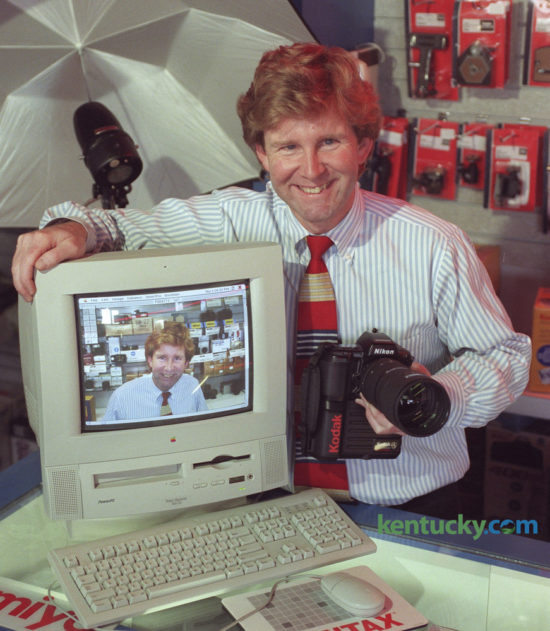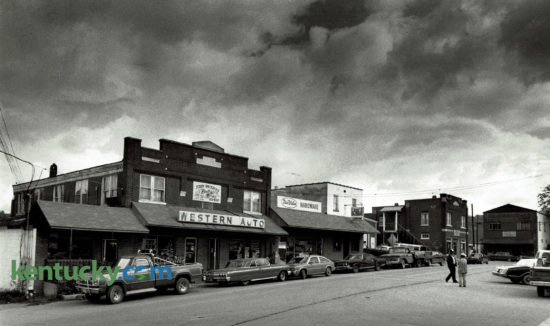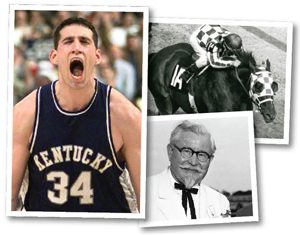November 4, 2025
Santa Train in Elkhorn City, 1986
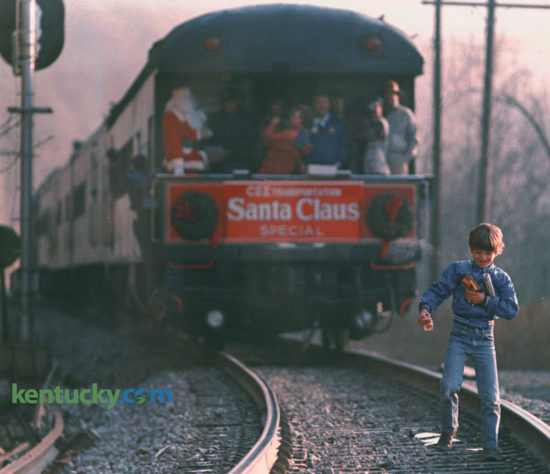
Mike Fields, 9, of Elkhorn City returned with an armful of gifts and a smile as the Santa Train headed for Virginia after making its last Kentucky stop at Elkhorn City on Nov. 22, 1986. This year’s Santa Train runs Saturday, making 14 stops on the rail line between Shelby, Ky., and Kingsport, Tenn., and marks its 75th year. A special guest this year is Appalachia native and music legend Ricky Skaggs. Photo by Jim Wakeham | Staff
‘Seabiscuit’ filming, 2002
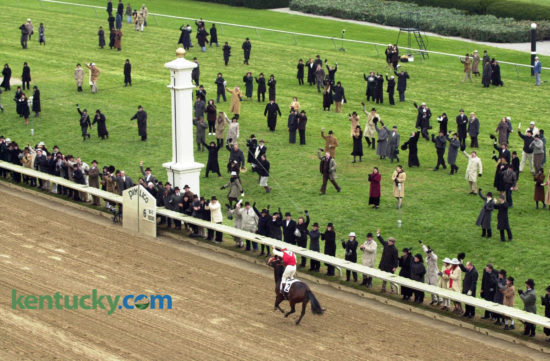
Jockey Gary Stevens, played jockey George Woolf in the movie “Seabiscuit.” In this scene, shot Nov. 17, 2002, the last day of filming at Keeneland, Woolf and Seabiscuit return after winning a match race between underdog Seabiscuit and Triple Crown winner War Admiral. More than 4,200 people turned out in the cold to be unpaid extras in one of the movie’s climactic scenes, a match race between underdog Seabiscuit and Triple Crown winner War Admiral, ridden by Chris McCarron during filming. The real real race was at Maryland’s Pimlico Race Course on Nov. 1, 1938. To portray it, Keeneland was redone to look like Pimlico, complete with the Maryland flag snapping over the old-fashioned tote board. “Seabiscuit,” produced by Universal Studios and based on the book by Laura Hillenbrand, starred Tobey Maguire, Chris Cooper and Jeff Bridges. Many other scenes were filmed around Central Kentucky, including Paris; Eastern State Hospital; and several horse farms, including Calumet. The film’s world premiere was July 19, 2003, at the Kentucky Theatre. Photo by Frank Anderson | Staff
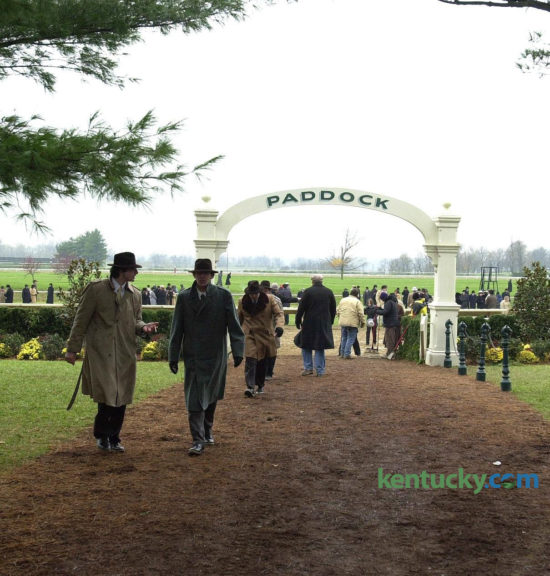
Extras walked from a paddock created by movie makers during the last day of the filming of “Seabiscuit” on Nov. 17, 2002, at Keeneland Race Course. Parts of Keeneland, including the infield, track, grandstand, clubhouse and lawn, were retrofitted to look like Pimlico Race Course circa 1938. The films makers were impressed with the more than 4,200 extras on hand. In Los Angeles, “No one would have shown up in the cold” to be an unpaid extra, executive producer Allison Thomas said. Photo by Janet Worne | Staff
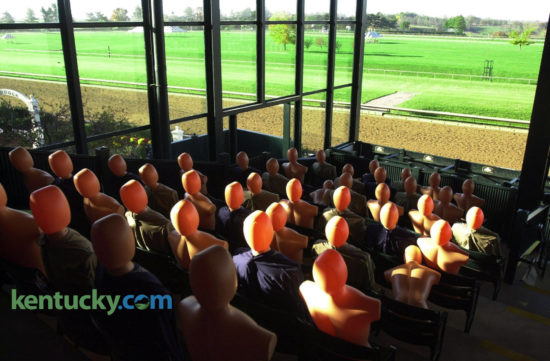
Inflatable people were used to create a crowd in the stands for the filming of “Seabiscuit” at Keeneland. More than 7,000 mannequins were made, but fewer than 5,000 were placed in the stands on Nov. 8, 2002. “Traditionally we use cardboard cutouts, but they’re two-dimensional,” said Joe Biggins, who was with the production company. “That’s not really good when you have cameras swinging around the turns of racetracks, because the audience is going to see they’re two-dimensional. So we needed to come up with a way to create a crowd that could be easily shipped and set up.” He said it would be too expensive to add a digital crowd for “Seabiscuit.” They looked like store mannequins without arms, legs or faces — but with six-pack abs and their own faces thanks to an artist in Simi Valley, Calif., who painted masks. “From far away, you’d never see the same face,” Biggins said. It took the crew about 12 seconds to inflate each dummy, which were all male, reflecting the fact that horse-racing crowds in the 1930s were mostly men. During filming, the crowd was interspersed with live female extras. Photo by Janet Worne | Staff
Vine Street parking lot, 1959
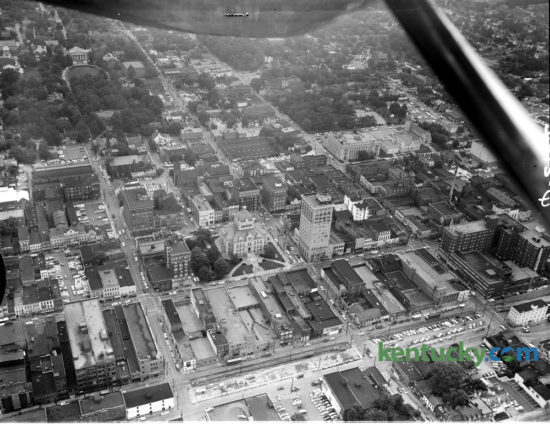
Aerial photo of downtown Lexington in August 1959 that showed a new parking lot ready for paving to provide approximately 65 parking spaces next to railroad tracks that paralleled Vine Street, one block south of Main Street. The buildings along Main Street at center included Security Trust, left, the Fayette County Courthouse and First National Bank. The new lot, built by Merchants Parking Association, was expected to be completed by late September. Herald-Leader Archive Photo
Kroger advertisement, 1977
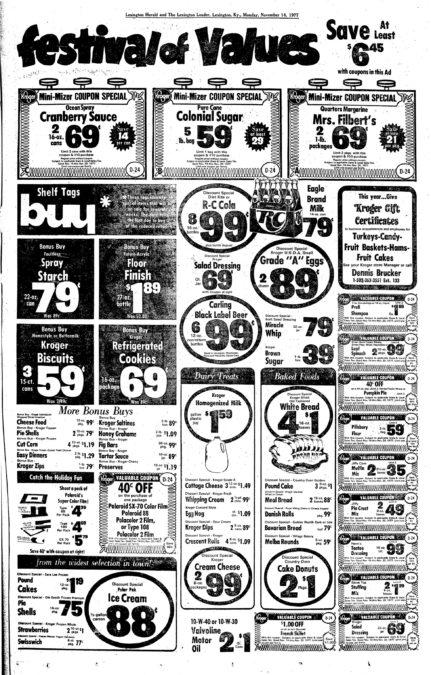
A full-page advertisement that ran in the Nov. 14, 1977, Lexington Herald and Lexington Leader. The Herald was the morning newspaper and the Leader published in the afternoon. The ad highlights that you could save at least $6.45 with the coupons. Among the items advertised: a five-pound bag of sugar for 59 cents; two dozen grade A eggs for 89 cents and four loaves of bread for $1. At that time, Lexington had six Kroger stores: 704 East Euclid Avenue, 97 Eastland Shopping Center 1865 Alexandria Drive 451 Southland Drive, 3222 Nicholasville Road, and 500 New Circle Road. Only two of those stores remain open today. Lexington now has 11 Kroger stores. Click on the image for a closer look, and click here to see other Kroger images from our archives.
Clothing construction class, 1946
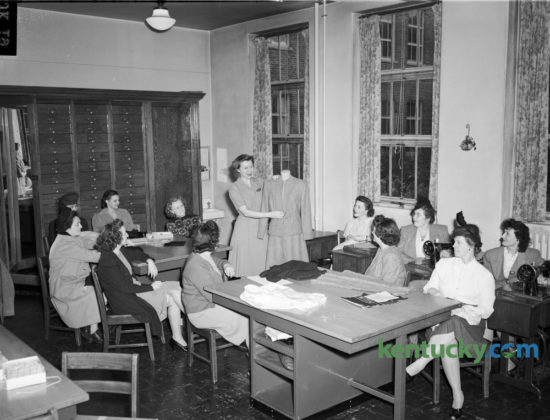
Above is part of group of 46 women who had been attending a class in clothing construction at Lafayette High school under the direction of Miss Ruth Averitt and Miss Thelma Monical in November 1946. The classes, which met at 3 p.m. each Tuesday, were free and open to the public. Herald-Leader Archive Photo
Kmart advertisement, 1976
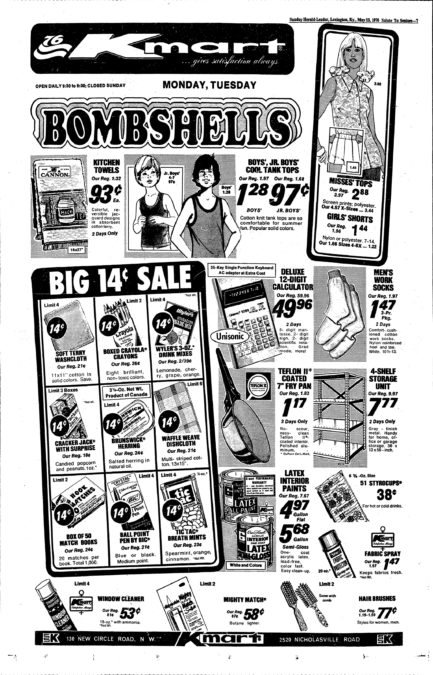
This full-page advertisement was in the May 23, 1976, Sunday Herald-Leader for Lexington’s two Kmart department stores. The ad details items available during a “Big $.14 Sale” that included a box of crayons, Cracker Jack, matches and other merchandise. A 12-digit calculator cost $49.96 — but the AC adapter cost extra. Click on the image for a closer look. At that time, Lexington had a Kmart store at 130 New Circle Road, which is now a Goodwill store, and at 2520 Nicholasville Road. That store, the last in Lexington, closed in October, and it was announced recently that it will become a Malibu Jack’s “family fun center.”
Veterans Day parade, 1956
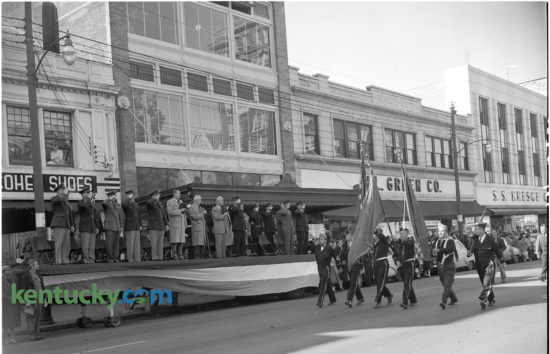
The American Legion color guard passed the reviewing stand on Main Street, across from the courthouse, during the Veterans Day Parade in Lexington on Nov. 12, 1956. An estimated 5,000 people withstood chilly temperatures and gusty wind during the parade. Two Air Force planes, North American T-28 Trojans, buzzed the parade route. Published in the Lexington Herald on Nov. 13, 1956. Click here to see another image from our archives of the parade. Herald-Leader Archive Photo
1946-47 Kentucky basketball team
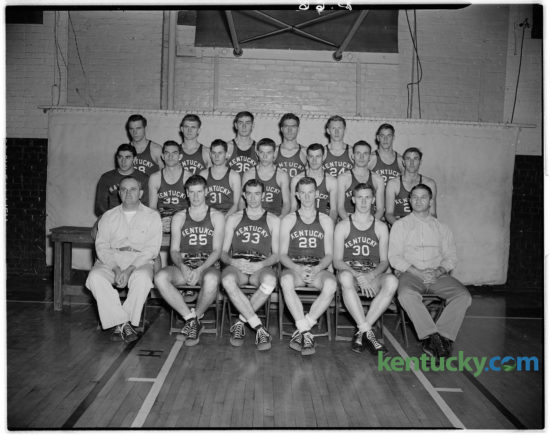
The 1946-47 University of Kentucky basketball team photo, taken in December 1946. The team ended the season 34-3 as SEC regular-season champions, SEC Tournament champions and NIT runners-up. The Cats outscored their opponents by an average of 30 points a game (68.5 ppg vs. 38.3 ppg). The three games they lost were by a combined 16 points. They were retroactively recognized as the national champion by the Premo-Porretta Power Poll. Pictured in the back row, from left, Ken Campbell, Joe Holland, Alex Groza, Bob Brannum, Malcolm McMullen and Wallace (Wah Wah) Jones. Second row,from left: manager Humsey Yessin, Mulford (Muff) Davis, Albert Cummins, Ralph Beard, Buddy Parker, Kenny Rollins and Cliff Barker. Front row, from left: Coach Adolph Rupp, Jim Line, Jack Tingle, Dale Barnstable, Jim Jordan and assistant coach Harry Lancaster. Beard, Groza, Jones, Barker and Rollins were dubbed the Fabulous Five after guiding UK to their second national title the following year. Click on the image for a closer look and note that the player sitting next to Rupp, No. 25 Jim Line, is wearing a jersey with an unfortunate misspelling. Published in the Lexington Leader on Jan. 31, 1947. The 2017-18 team tips off the season Nov. 10. Herald-Leader Archive Photo

